2016 April
About Andrew Cusack
 Writer, web designer, etc.; born in New York; educated in Argentina, Scotland, and South Africa; now based in London.
Writer, web designer, etc.; born in New York; educated in Argentina, Scotland, and South Africa; now based in London. read more
News
Blogs
Reviews & Periodicals
Arts & Design
World
France
Mitteleuropa
Knickerbockers
Argentina
The Levant
Africa
Cape of Good Hope
Netherlands
Scandinavia
Québec
India
Muscovy
Germany
Academica
A Baroque Church Portal
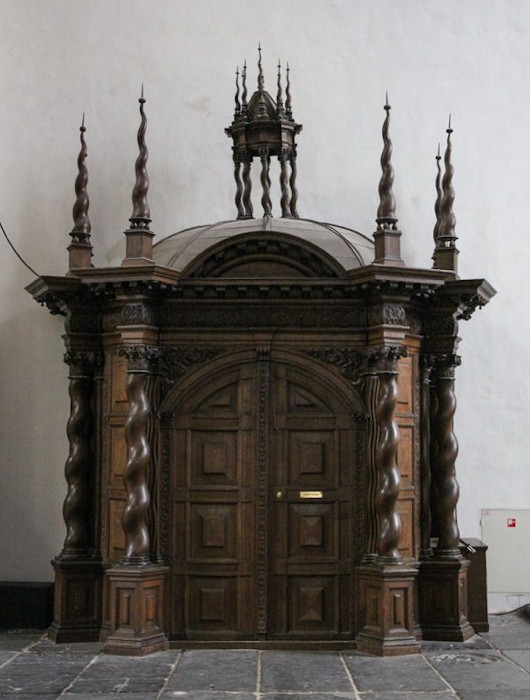
This church portal in the Oude Kerk of Amsterdam was originally in the Nieuwezijds Kapel, or Church of the Heilige Stede. That church was originally built in commemoration of the 1345 Miracle of Amsterdam, but after the ‘Alteration’ of 26 May 1578 — when Amsterdam’s Catholic city government was deposed and replaced by a Calvinist one — it and all the city’s other churches were taken over by the new Protestant administration.
In 1908 the elders of the Protestant congregation of the Nieuwezijds Kapel decided to demolish the fifteenth-century church and build a smaller one on the site, while building shops on the remainder of the site to prevent the resurgent Dutch Catholic church from building any chapel or shrine on it. This seventeenth-century baroque enclosed portal was then transferred to the Oude Kerk where it remains today.
Despite the anti-Catholicism of the Nieuwezijds Kapel elders in 1908, the Miracle of Amsterdam is still comemmorated every year on 15 March when thousands of pious Hollanders march in the evening Silent Procession (Stille Omgang). This year’s procession attracted 7,000 participants.
An Old Name Returns to Banking
or: What Daniel O’Connell has to do with the 2008 Banking Crisis
Daniel O’Connell was a remarkable man by any stretch of the imagination, and is most often recalled for his part in bringing about the Relief Act of 1829 which emancipated the Catholics of Great Britain and Ireland from an officially oppressed legal status. Among his many achievements, however, was in London in 1825 founding the National Bank of Ireland.
As the RBS Group’s website notes, O’Connell:
…helped draw up the agreement that established it, spoke at public meetings to drum up support for it, invested in it, attended its first board meetings and, in 1836, was appointed its governor. He became an important figurehead for the new bank and there was even a proposal, not implemented, to put a bust of O’Connell on the bank’s notes.
The National Bank was created with the aim of injecting cash into the rural economy in Ireland, and its charter ensured that half of its returns would accrue to local shareholders in the country. O’Connell, not the best manager of financial affairs, ended up accruing huge personal debts to the bank and had to be quietly bailed out by several others (commencing a tradition of surruptitious banking amongst the nation’s major politicians).
Anyhow, the National Bank expanded across Britain and Ireland. In 1966 its Irish core was sold to the Bank of Ireland, and the English and Welsh branches were acquired by the National Commercial Bank of Scotland (which was a 1959 merger of the National Bank of Scotland and the Commercial Bank of Scotland). This, in turn, merged into the Royal Bank of Scotland in 1969, with the superfluous National Bank branches being turned into Williams & Glyn’s Bank the following year. (more…)
A Land, not a Republic
Bohemians seek to rename Czech Republic as ‘Czechia’
What are we to make of the growing movement against the name ‘Czech Republic’? It seems a welcome development, although one has a certain hesitancy in adopting the name ‘Czechia’ which somehow just doesn’t ring true from the English tongue.
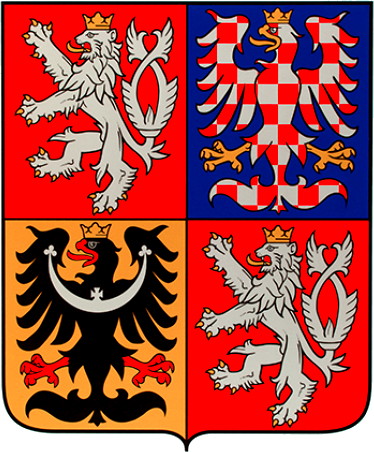 Many will still automatically recall ‘Czechoslovakia’, an artificial country invented in 1918 which lasted a surprising seventy-four years. Its two successor states will celebrate their twenty-fifth anniversary of independence next year, and perhaps this landmark event has provoked some introspection regarding the country’s name.
Many will still automatically recall ‘Czechoslovakia’, an artificial country invented in 1918 which lasted a surprising seventy-four years. Its two successor states will celebrate their twenty-fifth anniversary of independence next year, and perhaps this landmark event has provoked some introspection regarding the country’s name.
It’s not that the Czech Republic is alone: there are plenty of countries whose official names included an adjectival demonym — the French Republic, the Italian Republic, and the Hellenic Republic spring to mind. But these three examples all have names that more readily spring to mind — France, Italy, Greece — and which are used more frequently then the official state names.
Besides the Czech Republic, the only other example of a country known only as ‘the [demonymic adjective] Republic’ is the Dominican Republic, which cannot be known as Dominica owing the nearby sovereign island of the same name. (The island Dominica was named after Sunday whereas the DR was named after Saint Dominic, the patron of its largest city.) Even the Central African Republic is often referred to as Centrafrique (in French, at least).
Is it a move against republicanism? Not especially. When neighbouring Hungary adopted its new constitution it dropped the state name ‘Hungarian Republic / Republic of Hungary’ in favour of just plain ‘Hungary’ while maintaining a republican form of government. More influential perhaps is that it’s often viewed as a bit tinpot-dictatorship to have the word ‘republic’ in your country’s everyday name. (more…)
Michael Ellis
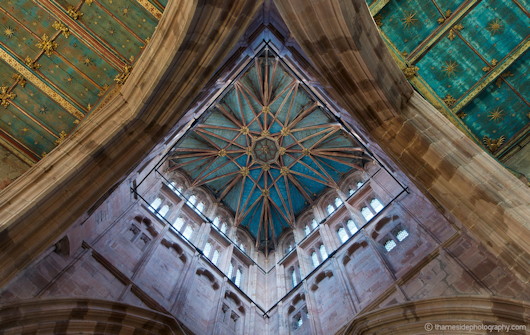
Stumbled upon the website of a firm called Thameside Media whose architectural photographer, Michael Ellis, has done some superb work in capturing English churches on film (metaphorical film, I suppose, now that the world has gone digital). (more…)
St Pancras Town Hall
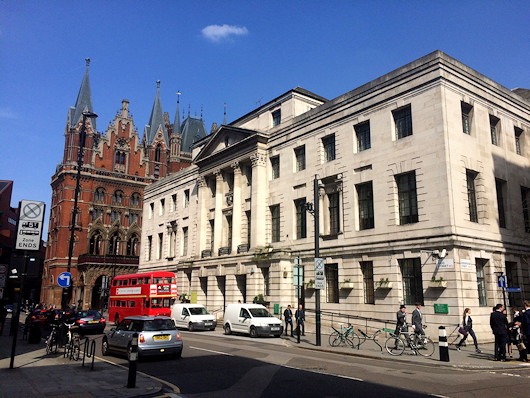
St Pancras Town Hall is an interwar classical building by the architect A.J. Thomas (of whom I know little). The façade is a little clunky but in the warmer months it’s adorned with arrangements of flowers that soften this stern civic edifice with a bit of welcome frivolity.
When the Metropolitan Borough of St Pancras was merged with the neighbouring bailiwicks of Hampstead and Holborn to form the London Borough of Camden in 1965 this was chosen as the town hall of the new entity, so it’s now referred to as Camden Town Hall.
But of course of all the buildings under the patronage of the fourteen-year-old, fourth-century martyr Pancras, the most prominent is the international railway station across the Euston Road (below) that connects this metropolis with the rest of the continent across the Channel.
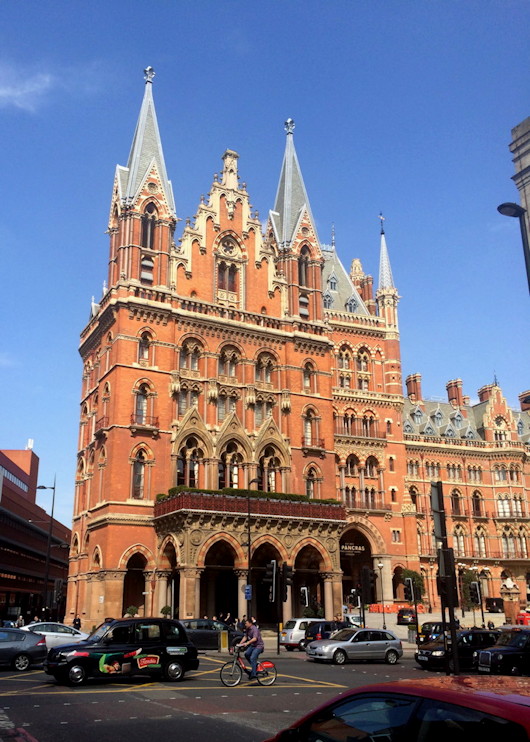
Master Mitsui’s Ink Garden
Daniel Mitsui is one of the most interesting artists out there, exhibiting a wide range of influences from the Celtic to the Oriental. Among his latest works is an ink drawing on a Catholic theme. As Daniel explains:
I received a commission to create a Catholic religious drawing in a Chinese style. These explorations into artistic traditions outside of European Christendom are always exciting, and China was new territory for me. When developing the concept for the project, I looked to one of the early missionaries to China, the Italian Jesuit Matteo Ricci.
Some time in the very early 17th century, Ricci gifted four European prints to the Chinese publisher Cheng Dayue: two engravings by Anthony Wierix from a series illustrating the Passion and Resurrection of Christ, another by the same artist reproducing the painting of the Virgin of Antigua in Seville Cathedral, and one by Crispin De Pas the Elder from a series illustrating the life of Lot.
Master Cheng copied these images into his Ink Garden, a model book of illustrations and calligraphy. The missionary saw this as a good opportunity to disseminate lessons in Christian doctrine and morality among the Chinese population.
Continue reading here.
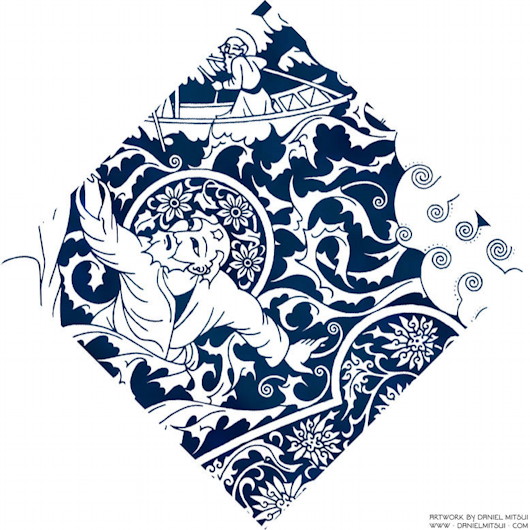
Canalside Wanderings
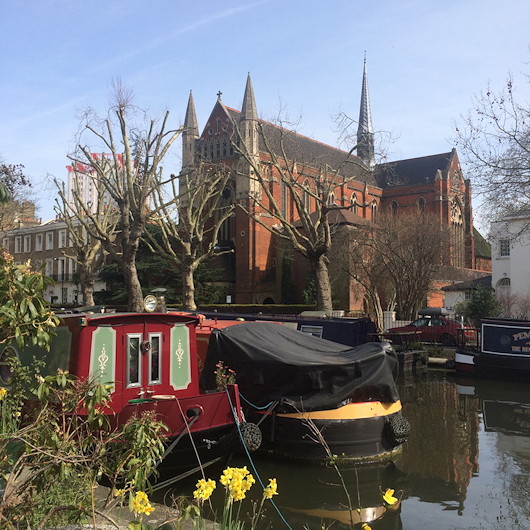
The sun put its hat on this weekend, and after a delicious and vaguely German breakfast by King’s Cross on Saturday I fancied a little canalside wandering. Walking the Regent’s Canal from the new Central Saint Martins all the way to Paddington, I stumbled across the Catholic Apostolic Church in Little Venice (above). It has been over ten years since I popped in to the former Edinburgh outpost of this strange and fascinating denomination, now much reduced in numbers since its apex in the late Victorian period. (more…)
Search
Instagram: @andcusack
Click here for my Instagram photos.Most Recent Posts
- Sag Harbor Cinema March 26, 2025
- Teutonic Takeover March 10, 2025
- Katalin Bánffy-Jelen, R.I.P. March 3, 2025
- Substack Cusackiensis March 3, 2025
- In the Courts of the Lord February 13, 2025
Most Recent Comments
Book Wishlist
Monthly Archives
Categories


